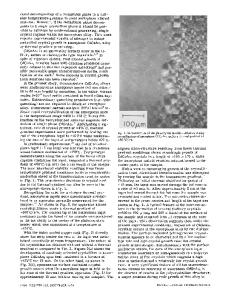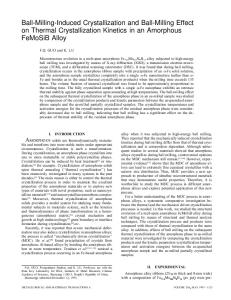Thermal stability, crystallization kinetics, and grain growth in an amorphous Al 85 Ce 5 Ni 8 Co 2 alloy
- PDF / 178,463 Bytes
- 7 Pages / 612 x 792 pts (letter) Page_size
- 76 Downloads / 313 Views
. Varga Research Institute for Solid State Physics and Optics, Hungarian Academy of Sciences, H-1525 Budapest, P.O.B. 49, Hungary
S. Surin˜ach and M.D. Baro´ Department of Physics, Faculty of Sciences, Universitat Auto`noma Barcelona, Edifici Cc, 08193 Bellaterra, Barcelona, Spain (Received 14 March 2002; accepted 3 June 2002)
Thermal stability and crystallization kinetics of the melt-quenched amorphous Al85Ce5Ni8Co2 alloy were investigated by x-ray diffraction and differential scanning calorimetry (DSC). The glass transition was followed by a supercooled liquid region (21 °C) and then by a two-step crystallization process. The final microstructure contained Al3Ce, ␣–Al, Al3Ni, and Al9Co2 phases. Isothermal annealing of the as-quenched samples in the range of 275–285 °C showed that both crystallization reactions occurred through a nucleation and growth process. Continuous heating DSC measurements following pre-anneals for different times were also carried out to study the crystallization kinetics and the stability of the material. The Avrami analysis of the isothermal DSC-curves revealed that the 3-dimensional nucleation and growth process became more dominant with increasing annealing temperature. The average specific grain boundary energy corresponded to high-angle grain boundaries and indicated independent nucleation events.
I. INTRODUCTION
II. EXPERIMENTAL
Conventional aluminum alloys have been well known for their use as light-weight components in engineering applications, particularly in the aerospace industry, for some time. Recently, it has been found that rapidly quenched Al-based alloys1,2 exhibit better mechanical properties, with high tensile strength and good ductility.3 The crystallization behavior of the Al–Ni–Y ternary4,5 and Al–Ni–Y–Co6–9 quaternary systems indicates a three-stage process with primary crystallization of the ␣–Al phase. Primary crystallization in the residual amorphous matrix is an important method for a wellcontrolled production of nanophase composite materials.10,11 The crystallization sequence in the Al–Ni– Ce system, however, strongly depends on the concentration of the constituents. As was shown by Tsai et al.,12 the single precipitation ␣–Al is not observed above 4 at.% Ce. This paper is concerned with the thermal stability, crystallization sequence, and the isothermal and nonisothermal crystallization kinetics in the Al85Ce5Ni8Co2 alloy.13,14 The effect of Co addition on the thermal stability of Al85Ni10Ce5 was also studied.
A. Sample preparation
2140
http://journals.cambridge.org
J. Mater. Res., Vol. 17, No. 8, Aug 2002
Downloaded: 15 Mar 2015
Ingots were prepared by induction-melting a mixture of pure (99.99 wt%) Al, Ce, Ni, and Co elements. The Al85Ce5Ni8Co2 ribbon (3–4 mm wide and about 20 m thick) was obtained using a single roller melt spinning technique in inert atmosphere with a Cu wheel rotating at a peripheral velocity of 39 m/s. The ribbon was ductile and in the form of several 10-cm-long pieces. B. Differential scanning calorimetry measurements
A Perkin
Data Loading...











